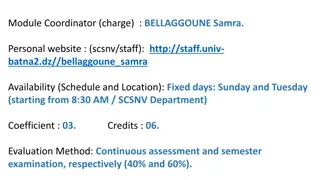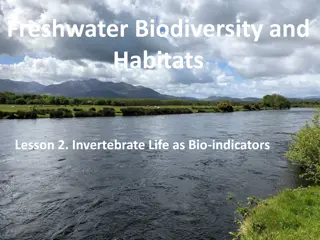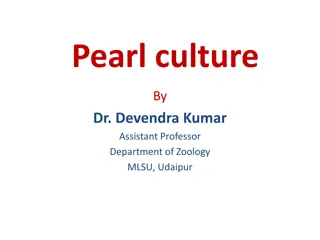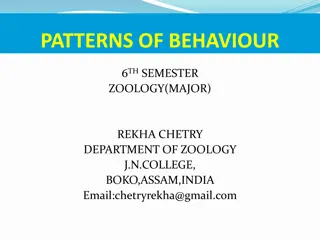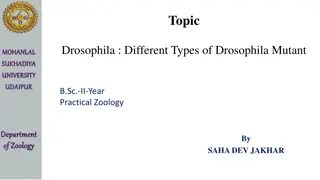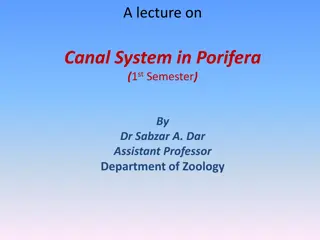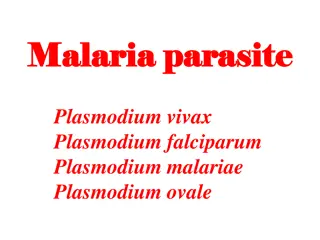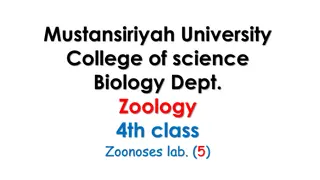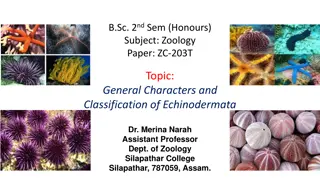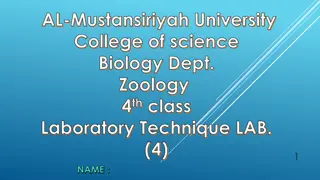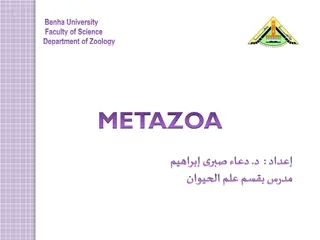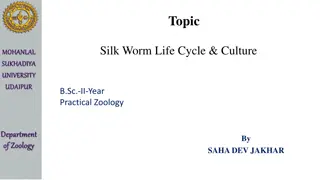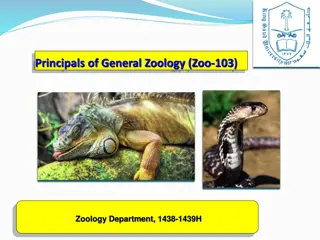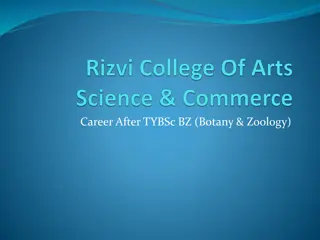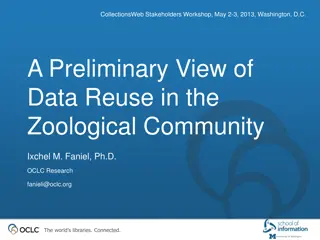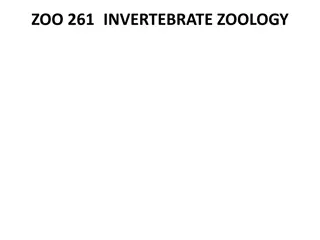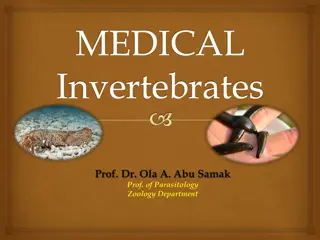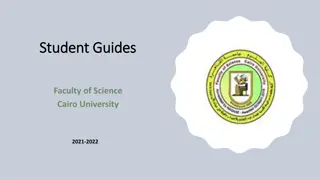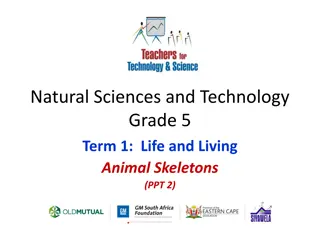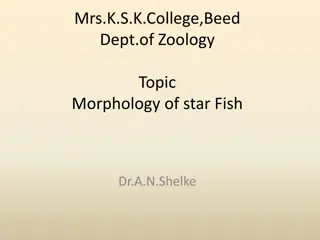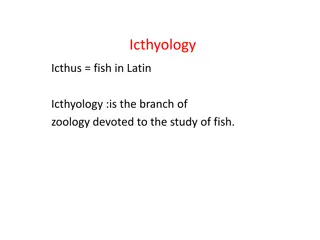Explore the Fascinating World of Zoology with Module Coordinator Samra Bellaggoune
Delve into the rich diversity of life on Earth as you discover the vast array of living organisms, from insects to plants, under the expert guidance of Module Coordinator Samra Bellaggoune. Learn about the estimated millions of species that inhabit our planet, the classification of animal and plant
3 views • 21 slides
Understanding Freshwater Biodiversity: Invertebrate Bio-indicators
Explore how invertebrates like stoneflies, mayflies, and caddisflies can be used as bio-indicators to determine water quality in freshwater habitats. Each species has specific environmental requirements, making their presence or absence a valuable tool for assessing the health of freshwater ecosyste
0 views • 16 slides
History and Culture of Pearls: A Comprehensive Overview by Dr. Devendra Kumar
Discover the intriguing world of pearl culture and history as Dr. Devendra Kumar, Assistant Professor of Zoology at MLSU, Udaipur, delves into the origins, significance, and production of pearls. From the natural rarity of pearls to the growth of cultured pearl farming, explore the historical ties b
1 views • 33 slides
Understanding Patterns of Behaviour in Zoology: An Overview
Behaviour in animals encompasses a wide range of responses to stimuli in their environment, with patterns that can be innate or learned. This comprehensive overview explores the different behavioural patterns, including tropism, taxis, reflexes, instincts, learning, and reasoning. The importance of
0 views • 17 slides
Exploring Different Types of Drosophila Mutants at Mohanlal Sukhadiya University
Discover the various Drosophila mutants, including Yellow Type, Ebony, Orange-eye, White Eye, Eyes Absent, Leg-headed, and Curly Wings, with unique genetic characteristics and visible phenotypes. This practical Zoology insight provides an in-depth look into mutations affecting body color, eye pigmen
0 views • 11 slides
Basics of Biology: Introduction, Branches, and Importance
Biology, the study of living organisms, encompasses various branches such as botany, zoology, morphology, and genetics. Understanding biology is crucial for solving environmental issues, conserving natural resources, and pursuing careers in diverse fields like medicine and agriculture. Living organi
0 views • 9 slides
Exploring the Anatomy and Behavior of Pila Globosa in Zoology
Discover the fascinating world of Pila Globosa, or the apple snail, through detailed descriptions of its habitat, external features, organ systems, and reproductive processes. From its adaptation to amphibious life to the intricate structure of its spiral shell, delve into the biology of this freshw
2 views • 21 slides
Understanding Canal System in Porifera: A Detailed Exploration by Dr. Sabzar A. Dar
The canal system in Porifera plays a vital role in water circulation within the body of sponges. Dr. Sabzar A. Dar, Assistant Professor of Zoology, elucidates the intricacies of canal systems in different types of sponges, such as Ascon, Sycon, Leucon, and Rhagon, highlighting their structures and f
0 views • 9 slides
Understanding Malaria Parasites and Their Life Cycle
Malaria parasites, including Plasmodium vivax, falciparum, malariae, and ovale, exhibit an alternation of generations phenomenon with a life cycle involving asexual and sexual phases. These parasites require both vertebrate and invertebrate hosts for development, with maturation stages involving gam
0 views • 30 slides
Understanding Dermatomycosis and Dermatophytes in Zoology
Dermatomycosis, caused by dermatophytes such as Trichophyton, Microsporum, and Epidermophyton, is a common skin infection by fungi. This article explores the characteristics, classification, development, preferred sites of infection, and more related to dermatophytes in the field of zoology.
0 views • 9 slides
General Characters and Classification of Echinodermata in Zoology: B.Sc. 2nd Sem
Echinoderms, marine animals with radial symmetry, feature a unique water vascular system. This content covers their general characteristics, five classes, and a classification table. Dr. Merina Narah from Silapathar College, Assam, presents valuable insights into the fascinating world of Echinoderma
0 views • 5 slides
Common Laboratory Techniques in Zoology - Urine and Stool Specimen Analysis
In the Biology Department at Al-Mustansiriyah University, students learn laboratory techniques for collecting and analyzing urine and stool specimens. The process involves random urine sample collection, urine tests for chemical components, urine culture, stool specimen analysis for pathological con
0 views • 10 slides
Demonstration of Salivary Enzyme Amylase Action in B.Sc. Practical
Salivary enzyme amylase, also known as ptyalin, plays a crucial role in breaking down starch and glycogen into maltose. This practical session in the Zoology department explores the action of salivary enzyme amylase at a temperature of 37°C and pH of 6.6. By conducting experiments with starch, iodi
0 views • 8 slides
Exploring the Fascinating World of Biology and Human Biology
Biology is a broad scientific field encompassing the study of living organisms and their various aspects, from anatomy and physiology to genetics and evolution. Branches of biology include anatomy, histology, cytology, physiology, embryology, genetics, molecular biology, biochemistry, zoology, botan
0 views • 21 slides
General Characteristics of Coelenterata in Zoology Department at Benha University
Coelenterata is a subkingdom of Metazoa with aquatic, symmetrical body structures found in marine or freshwater environments. It exhibits alternation of generations between polyp and medusa forms. Tentacles aid in food capture and defense, while unique stinging cysts called nematocysts are present.
0 views • 20 slides
Understanding Transition Bias and Substitution Models in Genetics
Transition bias and substitution models, explored by Xuhua Xia, delve into the concepts of transitions and transversions in genetic mutations, the causes of transition bias, the ubiquitous nature of transition bias in invertebrate and vertebrate genes, the mitochondrial genetic code, and RNA seconda
1 views • 25 slides
Silk Worm Life Cycle and Culture at Mohanlal Sukhadiya University Udaipur
The life cycle of silk worms, particularly Bombyx mori, is detailed in this practical study conducted by the Department of Zoology at Mohanlal Sukhadiya University, Udaipur. The process from eggs to larvae, cocoon formation, and the emergence of the adult silk moth is explained. Silk worms feed on m
0 views • 13 slides
Overview of Zoology: Principals, Objectives, Assessment, and Tips for Success
Delve into the fascinating world of Zoology with a detailed exploration of animal cell structure, tissue types, taxonomy, anatomy, physiology, and more. Learn about assessments, grading criteria, and tips for excelling in lectures. Understand the significance of biology in studying life, including t
0 views • 11 slides
Career Paths After Completing TYBSc in Botany and Zoology
Explore the various career options available after completing BSc in Botany and Zoology, including opportunities in paramedical science, post-graduation, and Ph.D. Specialize in top fields like Biomedical Science, Genetics, and Ecology. Dive into teaching roles, research in government or private sec
0 views • 14 slides
Exploring Data Reuse in the Zoological Community
Preliminary findings from a project funded by the Institute for Museum and Library Services led by Drs. Ixchel Faniel and Elizabeth Yakel delve into the intersection of data reuse and digital preservation in quantitative social science, archaeology, and zoology. The research focuses on identifying t
0 views • 12 slides
Understanding Fatty Acid Oxidation in Zoology Department with Miss Punam Patil
Explore the process of fatty acid oxidation in zoology, including the entry of fatty acids into mitochondria, TCA cycle outcomes, and differences between mitochondrial and peroxisomal oxidation. Learn about the oxidation of saturated, monounsaturated, and polyunsaturated fatty acids through detailed
0 views • 9 slides
Exploring the World of Invertebrate Zoology: Phylum Nematoda and Its Classes
In this detailed study of invertebrate zoology, we delve into the Phylum Nematoda, commonly known as roundworms. Highlighting their anatomy and classification, we examine the Ascarididae class, featuring Ascaris, and the Strongylidae class, represented by Ancylostoma. These simple yet diverse organi
0 views • 171 slides
Expectations of Research Students in Online Thesis Supervision for MPhil Programs
Exploring the expectations of postgraduate supervisees in online thesis supervision across five MPhil programs: Computer Science, Educational Leadership and Management, Business Administration, Mathematics, and Zoology. The study aims to investigate support, scheduling, resources access, communicati
0 views • 18 slides
Medical Invertebrates Course Overview
This course on Medical Invertebrates, led by Prof. Dr. Ola A. Abu Samak, provides an in-depth exploration of various invertebrate animals, their anatomy, physiology, and medical significance. Students will learn about the natural history, taxonomy, and infectious diseases of invertebrates, utilizing
0 views • 12 slides
Overview of Specializations Offered in the Faculty of Science at Cairo University
The Faculty of Science at Cairo University offers a variety of specializations for undergraduate students, including single and double specializations in disciplines such as Mathematics, Physics, Chemistry, Botany, Zoology, Geology, and more. Students can choose from a range of specializations based
0 views • 39 slides
Understanding Animal Skeletons in Grade 5 Natural Sciences and Technology
Explore the fascinating world of animal skeletons in Grade 5 Natural Sciences and Technology. Learn about the differences between vertebrate and invertebrate skeletons, the importance of skeletons in animal movement, and the various types of skeletons found in nature. Discover how vertebrates' skele
0 views • 11 slides
Morphology of Starfish at Mrs. K.S.K. College, Beed
Mrs. K.S.K. College in Beed, under the Department of Zoology, delves into the fascinating morphology of starfish. The external features of starfish, including its shape, size, and color variations, are explored. Specific focus is given to the radially symmetrical and pentamerous body structure of st
0 views • 14 slides
Understanding Ichthyology: The Study of Fish and Aquaculture
Ichthyology, the branch of zoology dedicated to the study of fish, plays a crucial role in meeting the growing global demand for animal protein. With aquaculture emerging as a vital source of protein, fish not only provide essential nutrients but also contribute to health and nutrition. The classifi
0 views • 18 slides
